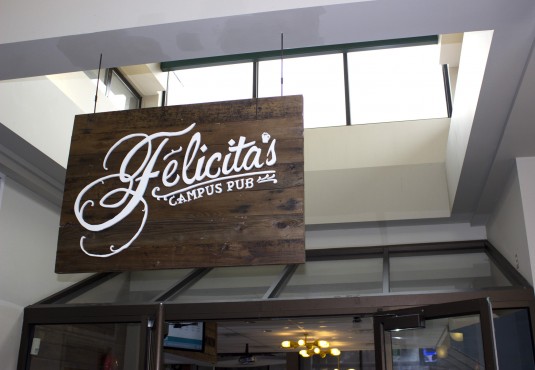
UVSS Food Services is budgeting for a $77 538 deficit next year, due in part to the way Felicita’s operates. Photo by Myles Sauer
A curious running deficit in the Food Services budget for the University of Victoria Students’ Society was brought up at the last Annual General Meeting on Oct. 28, with little explanation for the cause. An interview with Food Services Manager Brad Mielke, however, revealed a design in the accounting that indicates Food Services may be playing the patsy for Felicita’s losses.
The Food Services budget includes the main kitchen, Bean There, International Grill, and Health Food Bar/Juice Bar, but unlike these other operations, Felicita’s doesn’t directly pay kitchen expenses like labour and food costs. Instead, 79 per cent of Felicita’s food sales are given directly to the kitchen. According to Mielke, this percentage likely doesn’t cover the total labour and food costs that it actually takes to service Felicita’s. As a result, Food Services is left to make up the shortfall, and covering these extra costs has resulted in large deficits appearing for Food Services for the past several years, often in the tens of thousands.
“This is one of the things that always gets me, and it gets a lot of people,” says Mielke. All three operations under the Food Services budget “turn a good profit,” he says. But when the shortfall is accounted for, he says Food Services ends up in the hole.
According to the audited budgets posted on uvss.ca, Food Services ran a total deficit of $66 489 for 2014-15, and is projected to run a deficit of $77 538 for 2015-16. Although Felicita’s has made a profit for the last several years, this year they ran an audited deficit of $49 913. Felicita’s is projected to rebound from this deficit to make a profit of $5 050 in 2015-16.
Felicita’s General Manager Mike Murray confirmed he doesn’t cover any labour costs in the kitchen and doesn’t know much about the food sales commission.
The UVSS General Manager, Dale Robertson, and the Society’s interim Director of Finance and Operations, Kylie Pettifer [Editor’s note: Pettifer has since had her term extended until the end of the academic year.], explain that the kitchen acts as the central purchaser for all food-related businesses in the SUB, which ultimately makes it easier to do the accounting, though it makes it more difficult to know where exactly the deficit is being incurred.
“Basically we use the main kitchen as a cost centre, rather than a revenue-generating centre,” Pettifer says. “So in that way, when [the kitchen] makes food for Munchie Bar or Bean There, or something like that, they can just sell it to those organizations at cost instead of having a lot of the other costs associated with it.” However, as Mielke says, “As a cost center, the kitchen should come out to zero at the end of the day because all the costs should be distributed to where it needs to go.” Additionally, the commission on food sales system is unique to Felicita’s, and for Mielke, this can create confusion when it comes to explaining the fiscal status of Food Services at meetings.
“It gets highlighted when you have an AGM,” Mielke says, “and they hand [the budget] out and say, ‘look, Food [Services] sucks.’ So next year, people will be campaigning on the fact that they’re going to fix the Food Service Department. And in the meanwhile, the real problem isn’t [likely with] the Food Service Department.”
“Felicita’s has been the reason for, to my knowledge, a lot of the deficit in [the budget],” Pettifer allows, “and we are working towards changing that.”
Robertson, however, is hesitant to agree that Felicita’s would be showing a loss if the costs were separated out, saying “I think that’s a huge leap. That’s not accurate.” He notes that the kitchen budget includes salaries of people who oversee operations throughout the building, such as the purchaser. “I’d have to go through those numbers,” Robertson says, “but I really don’t think that’s the case.”
Mielke thinks the original reason for Felicita’s retaining a percentage of their food sales was intended to offset extra labour costs associated with switching to table service rather than window service (as Felicita’s used to run on a similar model to International Grill and Health Food Bar). The commission started at 14 per cent of the food sales, but has crept up over the years and is now at 21 per cent (although according to Robertson and Pettifer, the number is 17 per cent, not 21).
Mielke says it’s not his place to dictate how Felicita’s should be run, but he would like to see its expenses separated out on paper for the sake of clarity. He estimates that if Felicita’s kept all of its food revenue, then picked up its fair share of expenses from the kitchen, Food Services would show about $45 000 in profit for this year. “I’d just like to see the numbers fall where the numbers should fall,” Mielke says. “It gets really really frustrating over the years to go through this again and again and again.”








